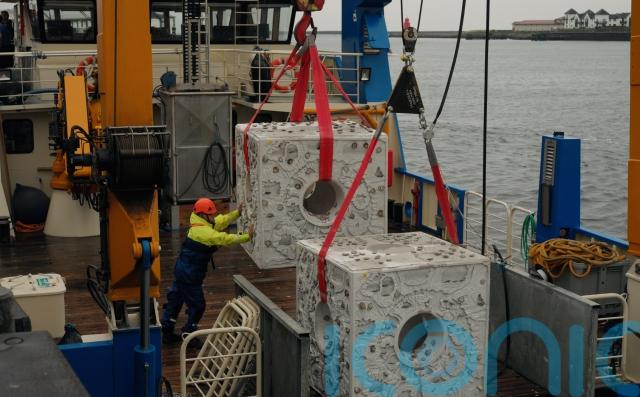
Concrete-like “cubes” housing 4,000 oysters have been deployed in the North Sea to protect the species from storms and tidal surges.
Marine conservationists from the Zoological Society of London (ZSL) and nature charity Groundwork released 20 specialised oyster reef cubes, made from six tonnes of sea water-resistant concrete alternative, called Marine Crete, off the coast of Tyne and Wear.
The team are trialling their use as ballasts to secure the native European oysters to the seabed – the first time that the approach has been deployed at this scale in the UK.
The project aims to support oysters to revive their reefs in the North Sea to help boost coastal water quality and biodiversity in the area.
A single adult oyster can filter around 200 litres of water – equivalent to a bath-full – each day, and their reefs can support other species by providing home to a range of fish, crabs and shrimps.

But native oyster reefs disappeared from the region more than a century ago while habitat loss, over-harvesting, pollution and disease have led to a decline in numbers of more than 95% across the UK since the 1800s, the conservationists said.
The latest oyster restoration efforts are part of a five-year restoration and conservation project that aims to restore marine life in the Tyne and Wear area.
Each oyster reef cube is engraved with ridges and textures to mimic natural marine surfaces and have large portholes in the centre to encourage marine life to shelter inside.
And to further support the restoration of oyster reefs in this area of the North Sea, the team deployed more than 35,000 juvenile oysters, or spat, attached to shells, along with 40 tonnes of repurposed scallop shells that will form the bed of a growing oyster reef, also known as cultch.
Celine Gamble, ZSL’s manager on the project, said: “They may be small, but oysters can play an important role in keeping our seas clean and healthy.
“As we work to restore native oysters in the North Sea, we are using novel techniques to help us contend with the challenges of restoring species in a challenging environment.
“The oyster reef cubes have been selected to help provide a stable environment for the oysters during storms, and we hope that over time they’ll also attract fish, sponges and crustaceans to the reefs as we work to restore this lost ecosystem.”

To prepare the 4,000 oysters for restoration, they were cleaned and scrubbed at North Shields Fish Quay in Tynemouth by 90 local volunteers to ensure that no other species were accidentally introduced during the restoration work.
A further 100 local volunteers helped to carefully attach the oysters onto the oyster reef structures, using specialist reef glue, before a survey vessel transported and lowered the artificial reefs, the spat and the cultch onto the seabed to a site 1.8km off the coast.
The deployment follows an earlier phase of the project in October 2023, when 10,000 mature native oysters were released off the coast of Whitburn, along with 750 tonnes of cultch.
However, monitoring revealed that a series of unprecedented weather events – including Storm Babet, a cyclone which hit the coastline just weeks after the oysters were released – dispersed some of those oysters and cultch away from the reef site.
With this further knowledge of the challenges that establishing oyster reefs face in the North Sea, the reef blocks were selected for this year’s restoration to make the oysters more storm-resilient as they become established on the seabed.
Dr Ashleigh Tinlin-Mackenzie, marine ecology technical lead for Tyne and Wear at Groundwork North East and Cumbria, said: “This project is breaking new ground.
“Like many innovative conservation initiatives, especially those working with nature, we’ve had to stay agile, learning, adapting and trialling new techniques to give native oysters the best chance of returning to our coastline.”
The five-year restoration and conservation project is funded by the Stronger Shores Partnership and led by South Tyneside Council, with funding from the Environment Department as part of programmes to drive innovation in flood and coastal resilience, and adaptation to a changing climate.
Subscribe or register today to discover more from DonegalLive.ie
Buy the e-paper of the Donegal Democrat, Donegal People's Press, Donegal Post and Inish Times here for instant access to Donegal's premier news titles.
Keep up with the latest news from Donegal with our daily newsletter featuring the most important stories of the day delivered to your inbox every evening at 5pm.